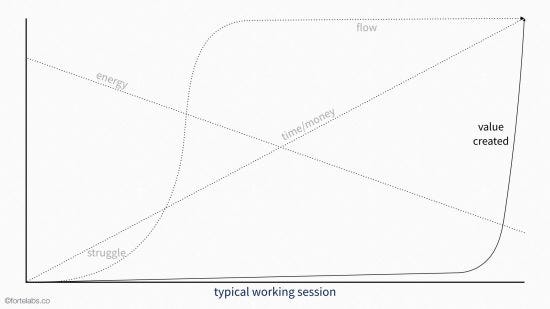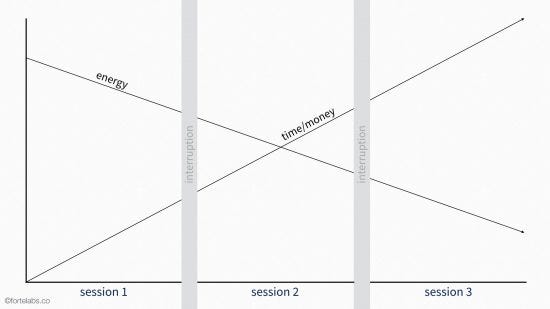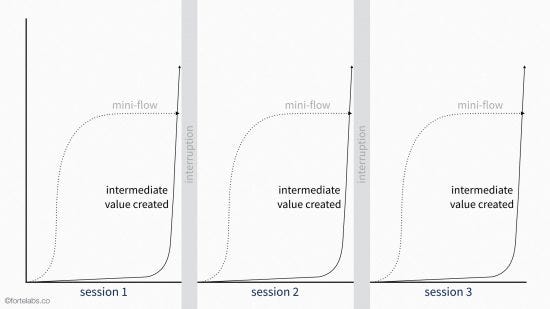Originally published on the Evernote blog
To learn more, check out our online bootcamp on Personal Knowledge Management, Building a Second Brain.
Consider a typical working session of a couple hours. You set aside the time, silence your phone, and clear your desk, determined to finish some Work of Real Value.
We know that time always passes at the same, unforgiving pace. And since time costs money, we could graph the two of them together like so:

Now consider the state of flow that you hope to get into to produce this Work of Real Value. We know that the first stage of flow is “struggle,” as your brain situates to the environment and “loads” the information relevant to the task at hand.
So your experience of flow over a couple hours looks something like this:

Notice how the flow curve dips below the time/money curve at the beginning. This is why setting aside a big block of time feels risky. If you’re going to spend that much time, you’d better have something to show for it.
Now let’s consider your energy level. This obviously depends on a lot of factors, but it’s safe to say that it starts towards the top of the range, and ends toward the bottom:

Notice where the energy and flow curves intersect. Essentially, your goal in the beginning of the session is to use your high energy to overcome the “struggle” stage. You’re hoping to leap onto and climb the cliff of flow before your energy drops too low or time runs out:

Now let’s add “value created.” This is definitely the most uncertain, but I would argue that virtually all the value in the typical individual working session is created at the very end:

One minute before you export that design and send it to the client, no value has been created. One minute before you attach your report to an email and send it to your boss with an explanatory note, no value has been created. One minute before your lovingly crafted product has been opened by your customer, no value has been created.
The goal of any employee’s working session, from your employer’s point of view, is for the value curve to intersect the time/money curve. If it doesn’t, you’ve spent more time and your company has spent more money than the value that was created. If value created exceeds time/money, that is what’s known as a “very productive day.”

With this simple (if totally unscientific) graph in hand, we can understand the modern productivity landscape. Every major “school” of productivity thought can be defined in terms of which curve it attempts to bend, and how.
The “Energy School” offers a variety of ways to get that energy curve higher. Better diet, more or different exercises, stretching and yoga, better sleep. If you can just keep your energy level high enough, their argument goes, your productivity will be great.
The “Focus School” is all about getting into and staying in flow. Meditation, goal-setting exercises, prioritizing schemes, avoiding distractions, no-meeting or no-phone days, accountability mechanisms, noise-canceling headphones, and many others. They argue that the best strategy is to pick a task and then hammer away at it until it’s finished, extending that flow curve as long as possible.
The “Efficiency School” is obsessed with the logistics of work. It advocates using technology or other people to automate tasks, learning keyboard shortcuts, improving reading and writing speed, ruthlessly cutting out all unnecessary activities, moving to Bali to cut down expenses, and other methods of cramming more productivity into the given amount of time and money represented by the time/money curve.
Now watch what happens when we don’t have a big block of time to set aside, or that block of time gets interrupted. In other words, the typical situation faced by most workers on most days:

Breaking our day into smaller segments has no effect on the time/money spent. You’re paid a fixed amount to be there a certain number of hours, regardless of how they’re divided up.
And there isn’t much effect on the energy curve either. You’re still tired at the end of the day, no matter how many or few sessions you’ve had.
The real impact of breaking up our day into smaller segments is on flow, or the lack thereof:

Since we don’t have enough time in one stretch to get into flow, we spend most of our day in struggle. We feel as if we’re interrupted from the current interruption by yet another interruption. This is how you can work hard all day, yet walk away with the distinct impression you didn’t get anything done.
Here’s a radical idea: what if this new workplace environment we find ourselves in is actually a good thing? What if we saw the constant stimulation not as interruptions and distractions, but as opportunities for rich feedback and connection? What if we used online networks as platforms for learning and collaboration, not as procrastination devices?
In other words, instead of fighting the direction the world is moving — drinking more coffee, cutting off our access to technology, and trying to force ourselves to focus — wouldn’t it be easier to flow with it? Or possibly even use it to our advantage?
I’d like to start a new school of productivity, the Value School. Its objective will be to shift the curve that usually gets taken for granted: the “value created” curve.
What we need to do is change the shape and size of the value curve to match the pace at which modern work moves. Instead of delivering value in a big package that spans huge amounts of time and money, we deliver it in smaller chunks at more frequent intervals:

This idea, of course, isn’t new. In the world of manufacturing, it is the equivalent of small batch sizes, a key part of the Just-In-Time vision that has propelled Toyota through 7 decades of growth to become the world’s largest automaker. In the world of software, it is known as continuous integration and deployment, a practice that has revolutionized the speed and quality with which the software we use every day is developed. In the startup world, Eric Ries has shown us in his book The Lean Startup how delivering value quickly in small chunks is essential for learning and innovation.
But we lack a framework for how individual employees can use small batch sizes to their advantage. If each worker in this new economy really is a Company of One, wouldn’t it make sense for us to use the same approach that has revolutionized manufacturing, software development, and startups?
What is keeping us from realizing this vision, I believe, is a mistaken assumption. This assumption is revealed when we ask the question: What is the “inventory” of knowledge work? What is the information age equivalent to the raw materials that flow through a factory?
The typical response is that “tasks” are the inventory of knowledge work. Many productivity strategies (like kanban boards) set “limits on work-in-process inventory” by limiting the number of open tasks that are allowed to be worked on at any given time. “Focus on one thing at a time!” we’re told.
But tasks are not inventory — they are nothing but abstract units of organization. No company “sells” tasks to their customers, and no employer will pay you for a completed to do list. The inventory of knowledge work is ideas. What you are selling, as a “worker of knowledge,” are the ideas you’ve “processed” through the focused application of your attention.
I think this makes people uncomfortable, because ideas are hard to quantify. We often hear that “ideas are cheap; only execution matters” and thus feel more comfortable in the execution of tasks than the generation of new ideas. Tasks are simpler, with only two possible states: done and undone. Whereas ideas exist on a much murkier spectrum of grays. Even our job titles designate certain people as “creatives,” with the rest presumably not expected to have any ideas.
If ideas are the inventory of knowledge work, then reducing our batch sizes requires changing not how we manage tasks and projects, but how we manage the information content of those projects.
We need to change our conception of what we are producing, from final deliverables to what I will call “intermediate packets.” Instead of seeing the final product (the deliverable we sell to the client) as the only repository of value, we package up all the intermediate steps — the research, notes, brainstorms, examples, outlines, prototypes, drafts, and even crazy ideas we choose not to pursue — as reusable components for later consumption.
At the end of the project, instead of making one final crazy all-night push to load every single part of the project into our brain for final delivery, our task is much easier: final assembly of the previously built packets.
This approach has numerous benefits:
1. Create value in any span of time
If we see our work as creating these intermediate packets, we can find ways to create value in any span of time, no matter how short. Productivity becomes a game of matching each available block of time with a corresponding packet of value.
Actually finishing things is critical to our motivation and morale. Why not redefine our work in smaller units that give us this feeling of completion at a more consistent pace?
2. Less intimidating
Big, ambitious projects are risky, because all the time you spend on it will feel like a waste if you don’t succeed. Often we don’t even attempt the big ones, because the path from here to there seems impossibly long and tortuous.
But if your only goal is to create an intermediate packet and show it to someone — good notes on a book, a Pinterest board of design inspirations, just one module of code — then you can trick yourself into getting started. And even if that particular Big Project doesn’t pan out, you’ll still have the value of the packets at your disposal.
3. Become interruption-proof
Organizing your work in intermediate packets has an extraordinary effect: you become interruption-proof. Because you rarely even try to load the entire project into your mind at once, there isn’t much to lose if someone taps you on the shoulder.
You can even start to see interruptions as a good thing: they remind you not to take on too much at once, to check in with others, to clear your mind and take a break once in awhile.
4. Better feedback
Another impact of breaking up your work into smaller chunks is that you can stop more often to get feedback. This is a critical skill as the pace of change in the marketplace accelerates. Part of the packaging of an intermediate chunk is that it becomes legible — others can get a sense of what it is and what it means, unlike your 25 pages of messy notes in a Google Doc.
And a much less appreciated consequence: people are more willing to give honest feedback on something that is merely work-in-process, whereas they’re hesitant to critique something that looks highly polished.
5. Productivity flywheel
After you’ve been working this way for awhile, there is a final benefit: you gain the ability to complete entire projects merely by assembling previously created packets. There seems to be a critical mass in a given industry or area — once you reach that mass, each additional packet added creates exponential value in the connections it creates with others.
This is the mythical productivity flywheel — a system that produces value almost on its own, while you take a back seat as curator, manager, and gatekeeper.
So what is required to make this new approach a reality? It requires us to get much, much better at packaging our work mid-stream. Here’s what makes it difficult: we can’t afford to do this packaging during the project, because every spare moment is needed to race toward the deadline. And we can’t do it after the project ends, because by then we’re already off to the next one. No, this packaging has to be embedded into the actual way we work moment to moment, so that it doesn’t take any extra time whatsoever.
This need for a new way of defining, packaging, and delivering knowledge work is why I believe the humble category of note-taking apps represents the next frontier of productivity. Their purpose is much different from file storage services like Box, Dropbox, and iCloud, as well as cloud-based suites like Google Drive and Microsoft Office 360. They don’t optimize for finished documents ready to be printed, or for convenient groupings of project files, or storage space or speed or collaboration or any of the other things one could optimize for.
Instead, they optimize for productive randomness, for serendipity, for seemingly bizarre juxtapositions of apparently unconnected information to train our capacity for connecting it. Each person possesses a unique lifestream of information from numerous sources, and success increasingly depends on curating, tweaking, redirecting, and capturing value from this stream to use in our work. Instead of hiding our insights and learnings in neatly labeled folders and files, we want to expose them as intermediate packets of ever-evolving, intermediate work.
Note-taking apps, simply put, are our best option for “bending” productivity to the ebb and flow of our days, and for managing the work-in-process inventory of ideas that represents our main asset as knowledge workers.
To learn more, check out our online bootcamp on Personal Knowledge Management, Building a Second Brain.
Follow us for the latest updates and insights around productivity and Building a Second Brain on Twitter, Facebook, Instagram, LinkedIn, and YouTube. And if you're ready to start building your Second Brain, get the book and learn the proven method to organize your digital life and unlock your creative potential.
